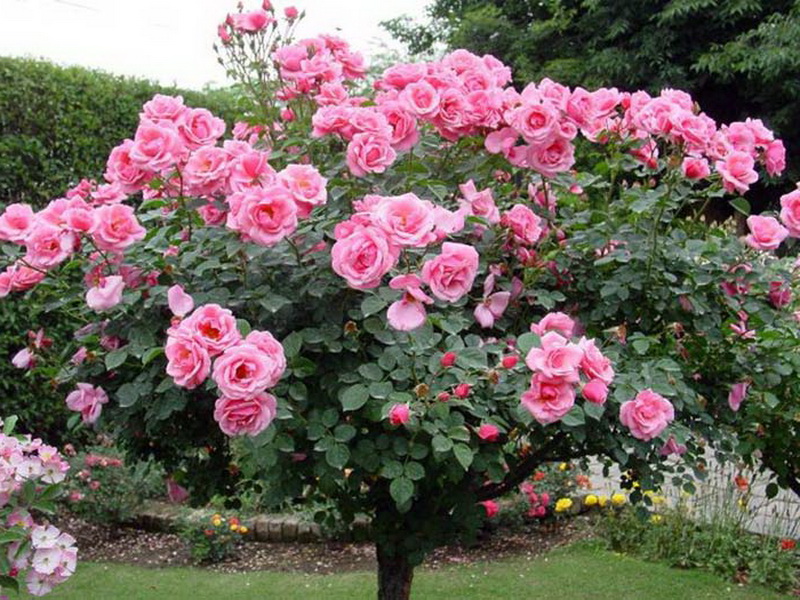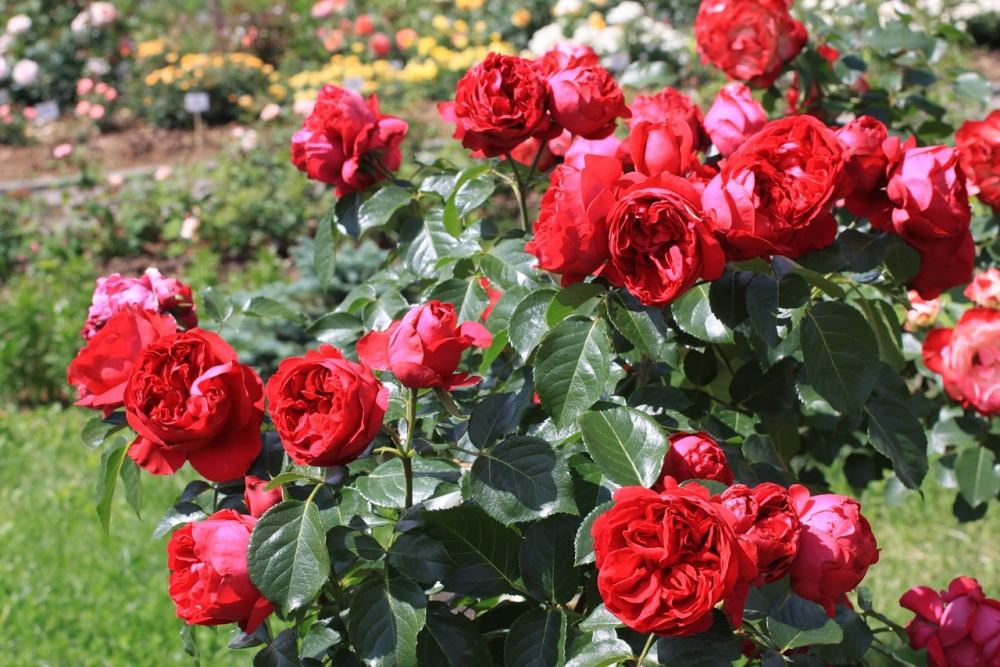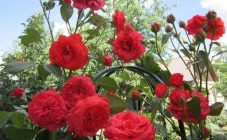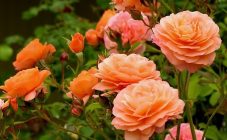The most famous and beloved by many is the rose. To date, many of its varieties have been bred for planting in any conditions. Therefore, everyone can choose a plant for themselves by color and flowering period, but red roses are considered an eternal classic.
Description of red roses
Roses are very ancient plants, but before they did not have such a variety of shades as they do now. Mostly in the gardens grew roses of red, white and pink colors. Today there are already about 30 thousand varieties of various colors and shades. And thanks to the efforts of breeders, their number is growing day by day.
The whole variety of roses is divided into several large groups, each of which has red (rose red):
- Hybrid tea... They are characterized by large flowers up to 15 cm in diameter. They have strong stems and are well suited for cutting. The flowering is undulating, several times per season.
- Climbing. Vigorous bushes grow up to 3 m tall. They need support. Old varieties of climbing roses bloomed once, but for a long time, new developments of breeders are already re-flowering.
- Floribunda... These roses appeared in the twentieth century, are the result of crossing hybrid tea, musk and polyanthus roses. They bloom almost continuously, the buds are collected in clusters of 3-9 pcs. The diameter of one such rose is within 7 cm. There are low, medium and high varieties in this group. There is also a wide variety of colors and shapes. There are even terry varieties.
- Grandiflora... They have large flowers up to 15 cm in diameter and bloom almost continuously. Grown for cutting, have great vigor and winter hardiness.
- Miniature... Suitable for open ground and for container planting. The height of such plants is up to half a meter, and the size of the flowers is 5 cm. They are diverse in color, bloom continuously almost until November.
- Groundcover... Very resistant to external influences - droughts, trampling, frost. They grow in wide, powerful bushes, bloom profusely and for quite a long time.
- Park (shrabs)... Bushes grow up to 2 m high. No support is needed. They are characterized by repeated flowering and have good winter hardiness.
Characteristics of popular varieties of red roses
Red roses are presented in many varieties belonging to different groups:
- Rose Red Paris... Hybrid tea rose. It has flowers 7 cm in size, bright red color with a slight shade of burgundy. Terry variety, forming buds in the shape of a glass with 45 petals. Good for cutting. Bush up to 90 cm high is densely covered with leaves. The rose blooms profusely and almost continuously. Resistant to disease and frost.
- Red Eden Rose... The French variety Red eden Rose is a rose that is commonly called climbing. The bush stands upright and has many shoots reaching one and a half meters. The width of the bush is about 80 cm. There are very few thorns. Dense double flowers up to 10 cm in diameter, collected in clusters of 3-5 pcs., Do not fade in the sun. The aroma is strong enough. The variety is suitable for cutting. Blooms several times per season. Frost-resistant and resistant to typical diseases.
- Red Sensation... The variety belongs to the patio group (or spray, as it is also called). Bred in 2010. The color is maroon, goblet-shaped flowers up to 7 cm in diameter, double. The bush is dense and low. There are practically no thorns on the rose. The rose blooms in waves several times per season.It has good winter hardiness and is very unpretentious, resistant to diseases.
- Rose Alex Ed. Rose Alec’s red has large double flowers up to 16 cm in diameter, rich cherry color. Petals per bud from 30 to 40 pcs. The flowers are solitary, do not fade and are resistant to rain. The plant has a good immunity to disease. Long and repeated flowering.
- Rose Red Leonardo da Vinci... The variety was bred in 1994, is included in the collection of a French company, in which roses were named after famous people of the past. The bush is powerful, grows up to 1 m in height. Blooms profusely and for a long time. The number of petals in a bud is from 70 to 80 pcs. Flower up to 10 cm in size. Resistant to cold and disease.
- Red haze... Belongs to the group of ground cover. The variety was bred in Germany in 1993. A creeping bush with densely leafy shoots. Roses up to 6 cm in diameter, non-double, scarlet color without aroma. Blooms all season.
- Carpet. It has small dark green leaves with a glossy surface. Due to the fact that there are a lot of them, the bush looks spectacular. The flowers are small, but there are also a lot of them. The color is closer to pink.
- Red River. The variety was bred in 1986. It belongs to the floribunda group, it grows up to 40 cm. It blooms all season. Unpretentious care. The flowers are fiery red. Disease and frost resistance is high.
- Red flame... An upright bush with double fragrant flowers up to 12 cm in diameter. Long bloom: from mid-summer to late autumn. The rose is resistant to frost and major diseases.
- Red lace... The flowers of this variety are bright ruby red. There are many leaves, and they effectively emphasize the buds. The rose is suitable for cutting.
- Red Macarena... This is a representative of patio roses with double flowers 4 cm in diameter, pomegranate color. On one bush, up to 4-5 buds. It has a height of about half a meter and a width of 40 cm. It blooms from spring until frost. This rose is sensitive to rain, but is not afraid of frost and disease, especially resistant to fungal diseases.
- Red micado... A patio rose with scarlet double flowers up to 4 cm in size. The bush grows up to 70 cm. Flowering is long, and the plant itself is undemanding to care for. It tolerates frost well.
- Red eden... It grows up to 2 m, suitable for cutting. The flowering period is from June to September. Demanding good lighting.
- Rose Drift Red... It is a double-flowered plant with 25 petals and 4 cm in diameter. The aroma is pleasant. There are yellow blotches on the bright red background of flowers. The plant blooms from May to November. The bush is 80 cm wide, and reaches 30 cm in height. It has an increased immunity to diseases, it tolerates frosts well down to -30 ° C.
- Red Empire. Belongs to the floribunda group. Bred in 2003. Round bush up to 75 cm high. Flowers up to 7 cm in diameter, semi-double in the shape of a bowl. The rose belongs to the re-flowering.
- Red passion... Refers to floribunda roses. The height of the plant is about 120 cm. The flowers are red, terry, collected in inflorescences of 15 pcs. Blooming in waves throughout the season.
- Red Star. A representative of the hybrid tea group, a rather old variety from 1974. The bush is up to 110 cm high. Flowers are about 12 cm in size. It tolerates frost under cover. Suitable for any climate.
- Red yesterday... Ground cover rose about 80 cm high. Flowers are small up to 3 cm in diameter with 4-8 petals. Flowering continues continuously.
- Lovely red... Belongs to the group of hybrid tea. The petals are velvety dark red. The shape is classic in the form of a glass. The bud is distinguished by the fact that it blooms smoothly and retains its shape. Perfect for cutting. Blooms for a fairly long period.
- Ruby Red... This rose is two-tone - it combines burgundy and pink-silver colors. The bush grows up to 110 cm in height and up to 80 cm in width. Flowers with a diameter of 10 cm. Has a high resistance to rain, frost and disease.
Agrotechnics
A place for planting roses should be chosen well-lit. If there is shading, then it should come no earlier than 18.00. Then the plant will bloom for a long time.
The soil should be loose, nutritious, and moisture permeable.The rose is not planted in lowlands, next to buildings or in areas with shallow groundwater.
The rose spends a lot of energy on abundant flowering, so fertilizing should be done 5-6 times per season with an interval of about 20 days. In the spring, a mullein is introduced, during the budding and flowering period, the kemira-wagon means. It is important to feed the rose with fertilizers containing magnesium, potassium and phosphorus. Before winter, the bush is sprayed with potassium sulfate.
As for pests, aphids, thrips, leaf rollers, spider mites, and rose leafhoppers can be found on roses. In the presence of insects, damage appears on the leaves and shoots. Modern insecticides can effectively control pests. Laundry soap is widely used from folk remedies.
For the winter, roses are covered with spruce branches, having previously removed from the support. If there is not enough snow, then they also throw a snowdrift on top.
The achievements of modern breeding allow both beginners and experienced gardeners to grow roses. The variety of shapes and colors is amazing. This is evidenced by the presence of a huge number of varieties of red roses.















